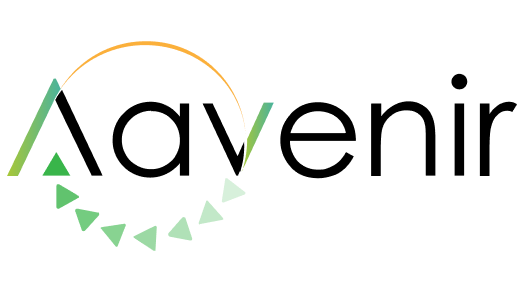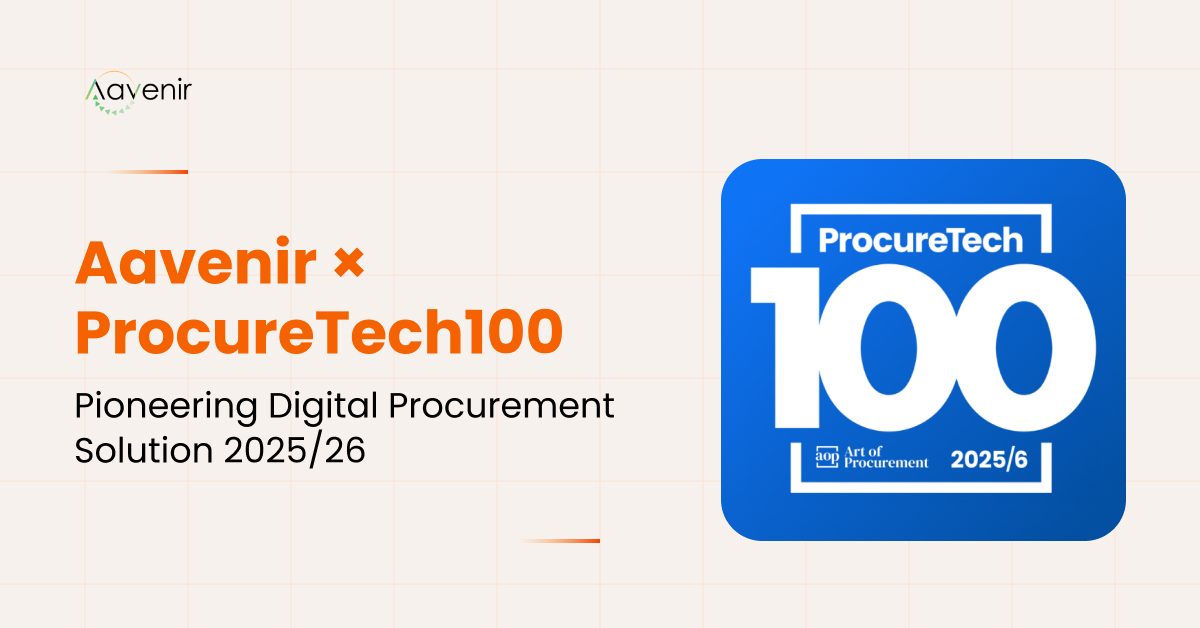eSourcing gets companies the best supplier through competitive bidding for required goods and services. eProcurement emphasizes the efficient purchasing and management of those goods and services. While both intricately link with each other in the broader process of partnering with external stakeholders, they differ quite a bit.
eSourcing gives teams access to a broader supplier network and brings multiple valid choices for the organization. eProcurement ensures that the organizations seamlessly execute purchase decisions while cutting costs and ensuring compliance. Understanding the differences enables teams to run the associated workflows more efficiently and effectively.
This article delves into the key differences between eSourcing and eProcurement while exploring strategies for seamless integration to optimize and enhance purchasing operations.
What is eSourcing?
eSourcing is a strategic process that uses electronic tools identify and approve procurement needs for goods and services. This includes requesting and soliciting quotes and bid responses from various suppliers, fairly selecting the most suitable supplier, and negotiating, and awarding contracts based on predefined selection criteria.
Key functions of eSourcing include supplier identification, bid solicitation, and proposal evaluation. Digitally performing the corresponding action items expedites the overall process and creates a centralized source of information. It helps sourcing teams communicate effectively with potential suppliers and collect relevant data for informed decision-making.
Aavenir RFPflow aids in eSourcing by accelerating the creation of RFx documents. Features such as a comprehensive question library, configurable templates, and collaborative tools allow sourcing teams to prepare 50-70% of an RFx in minutes.
What is eProcurement?
eProcurement begins with the execution of the actual contract and comprises the electronic process of managing the procurement transaction and compliance, including requisition, authorization, ordering, receipt, payment, and monitoring of suppliers.
It automates the purchasing workflow, manages electronic transactions, and covers requisition to payment. Automating these tasks reduces manual errors, accelerates procurement cycles, and ensures compliance with organizational policies. Additionally, eProcurement provides real-time spend visibility, improving budget management and cost control.
Key functions of eProcurement include requisition management, purchase order processing, invoice handling, and payment facilitation. The procurement team uses the same RFx documents — such as RFPs and RFQs — as sourcing teams.
Aavenir RFPflow solution streamlines eSourcing and eProcurement processes by offering a unified platform for creating, managing, and evaluating RFx documents. This integration minimizes confusion, ensures consistency, and enhances collaboration between sourcing and procurement teams.
As both sourcing and procurement teams leverage the same data for their respective processes, confusion may arise without clear process delineation.
eSourcing vs eProcurement – 3 Key Differences
Understanding the differences between eSourcing and eProcurement ensures businesses deploy the right tools and strategies for maximum efficiency and cost-effectiveness.
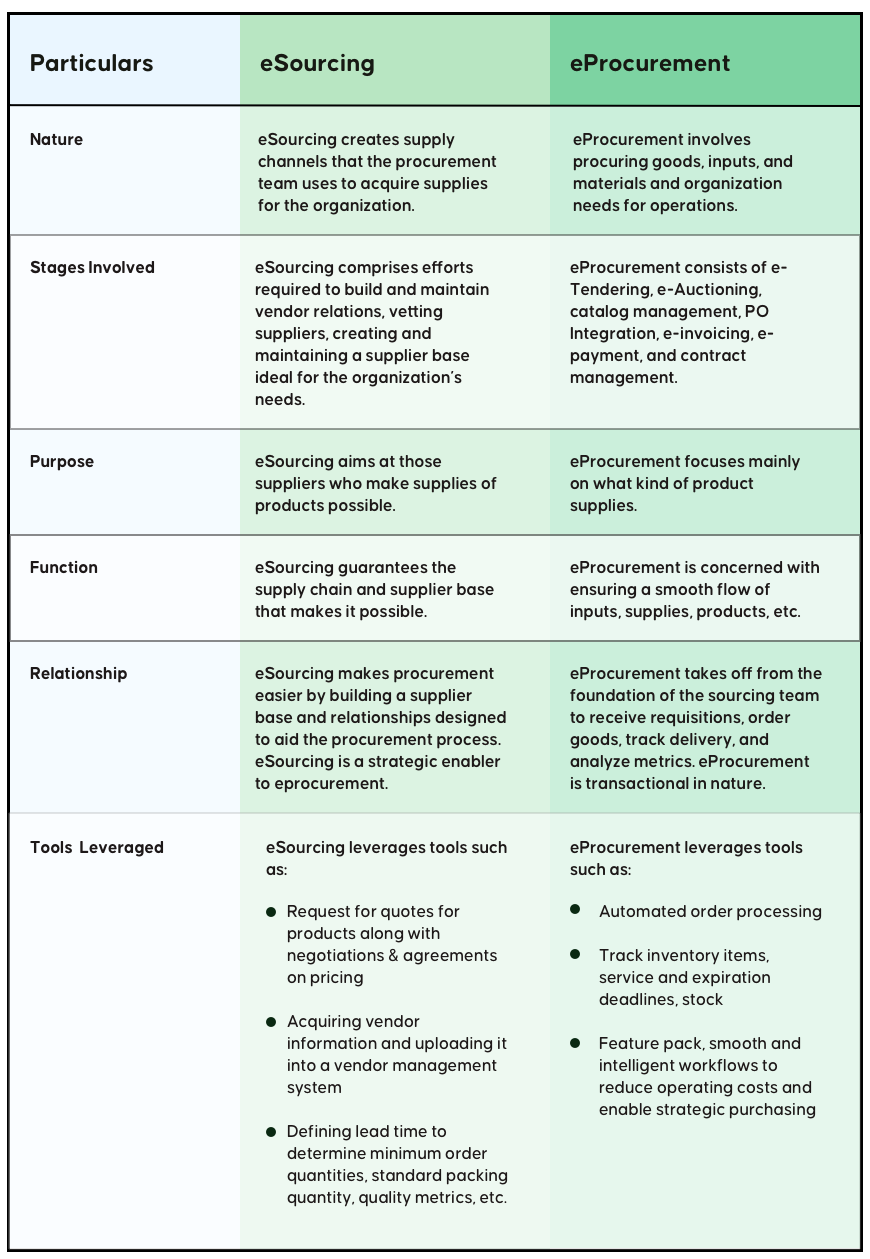
While both processes may overlap in certain areas, they are distinct from one another in three aspects:
1. Process Stage
eSourcing operates in the pre-purchasing phase of procurement. It focuses on strategic tasks like supplier identification, market analysis, and contract negotiations.
This stage is vital for building a strong foundation, ensuring the organization partners with suppliers who meet cost, quality, and compliance requirements.
eProcurement, on the other hand, occurs during the purchasing phase. Once suppliers are selected and contracts are finalized, eProcurement manages the operational tasks of placing orders, tracking deliveries, and processing payments.
This phase emphasizes smooth execution and efficient resource utilization.
2. Key Objectives
The primary objective of eSourcing is to identify and collaborate with the best suppliers while securing favorable terms and conditions. It helps businesses improve their competitive position by leveraging supplier bids, market data, and historical performance.
In contrast, eProcurement seeks to streamline the execution of procurement activities. It ensures purchases align with organizational policies, reduces manual errors, and enhances transparency in procurement operations.
3. Functional Focus
eSourcing is inherently strategic, dealing with activities like creating and managing RFx documents, evaluating supplier responses, and negotiating contracts.
It requires data-driven decision-making and close collaboration between sourcing teams and key stakeholders to achieve optimal outcomes.
However, eProcurement is transactional, focusing on requisition approval, purchase order management, invoice reconciliation, and payment processing. Its goal is to automate routine tasks, saving time and resources while ensuring compliance with procurement regulations.
Why Integrate eSourcing and eProcurement
The three key positives of integrating eSourcing and eProcurement include:
- Seamless Workflow: A continuous flow from supplier selection to order fulfilment, reducing manual interventions and errors.
- Unified Data and Scalability: Shared data and insights between eSourcing and eProcurement improve decision-making, providing a unified view of procurement activities. In short, integrating eSourcing and eProcurement systems helps foster improved cross-functional collaboration, boosts scalability to meet growing business needs, and drives more strategic and efficient procurement processes.
- Improved Supplier Relationships: A cohesive system fosters better supplier collaboration and communication, strengthening partnerships and performance.
Steps to Successfully Integrate eSourcing and eProcurement
Teams can streamline their procurement operations by following these five steps:
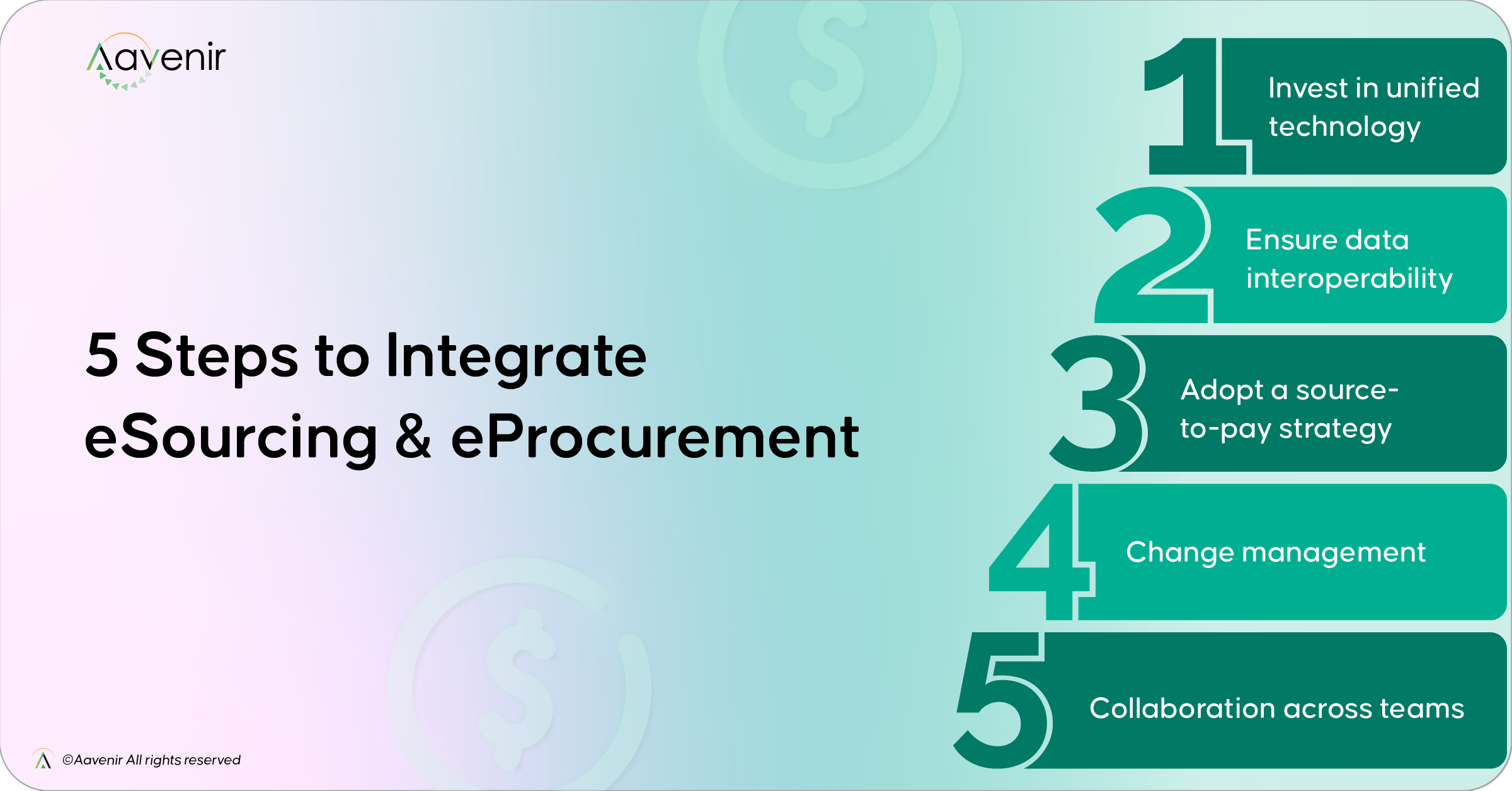
1. Invest in Unified Technology
Look for solutions offering end-to-end capabilities, such as source-to-contract (S2C) and source-to-pay (S2P) frameworks. This will eliminate silos within teams and always enable complete visibility.
Moreover, teams can reduce redundancy and easily transition from supplier selection to order fulfillment.
AI-powered integrated S2C and S2P solutions such as Aavenir also deliver real-time insights into sourcing and procurement data. Teams can make informed decisions while maintaining operational consistency.
2. Ensure Data Interoperability
Data interoperability refers to exchanging data seamlessly between eSourcing and eProcurement systems. This enhances workflow automation as manual data entry decreases.
Companies can achieve this by using application programming interfaces (APIs) or middleware solutions that bridge communication gaps between platforms. While doing so, teams must implement robust data security protocols compliant with the latest industry standards.
3. Adopt a Source-to-Pay (S2P) Strategy
Source-to-pay (S2P) keeps all tasks related to sourcing and procurement under one tab. This ensures greater visibility and control over procurement operations. Teams can always see where a particular negotiation is in their workflow pipeline, enabling agility.
Moreover, S2P strategies leverage advanced analytics and automation to streamline procurement cycles, reduce costs, and improve compliance.
4. Change Management
Change management ensures that employees comfortably transition to the new systems or processes. Organizations can effectively manage change by investing in employee training and conducting hands-on workshops.
Furthermore, communicating the nature and reasoning behind the changes beforehand is crucial. It reduces internal friction as all stakeholders can see the transition’s benefits.
5. Collaboration Across Teams
Teams are the most important component that ties eSourcing and eProcurement. Organizations should empower employees to collaborate with others across departments and silos to achieve goals.
Open communication channels facilitate easier sharing of data and updates among stakeholders. This will streamline aligning efforts and prioritizing tasks through transparency and accountability.
How to Address Implementation Hurdles When Integrating eSourcing and eProcurement
Even though integrating both systems can enhance procurement efficiency, it will have its share of challenges. One common roadblock is data migration issues, where irregularities or outdated information can disrupt workflows. The second is resistance to user adoption, as employees may be reluctant to embrace new processes or technologies. Moreover, system compatibility concerns, such as integrating the new solution with existing enterprise tools like ERP or finance systems, can also create hurdles.
To address these hurdles and unlock the full potential of their eSourcing and eProcurement solutions, organizations should proactively work towards streamlining the integration process:
- Prioritize data cleansing and validation before migration to ensure accuracy and consistency.
- Conduct comprehensive employee training and encourage a culture of change through clear communication to ease user resistance.
- Leverage middleware solutions or APIs to bridge compatibility gaps, facilitating seamless communication between systems.
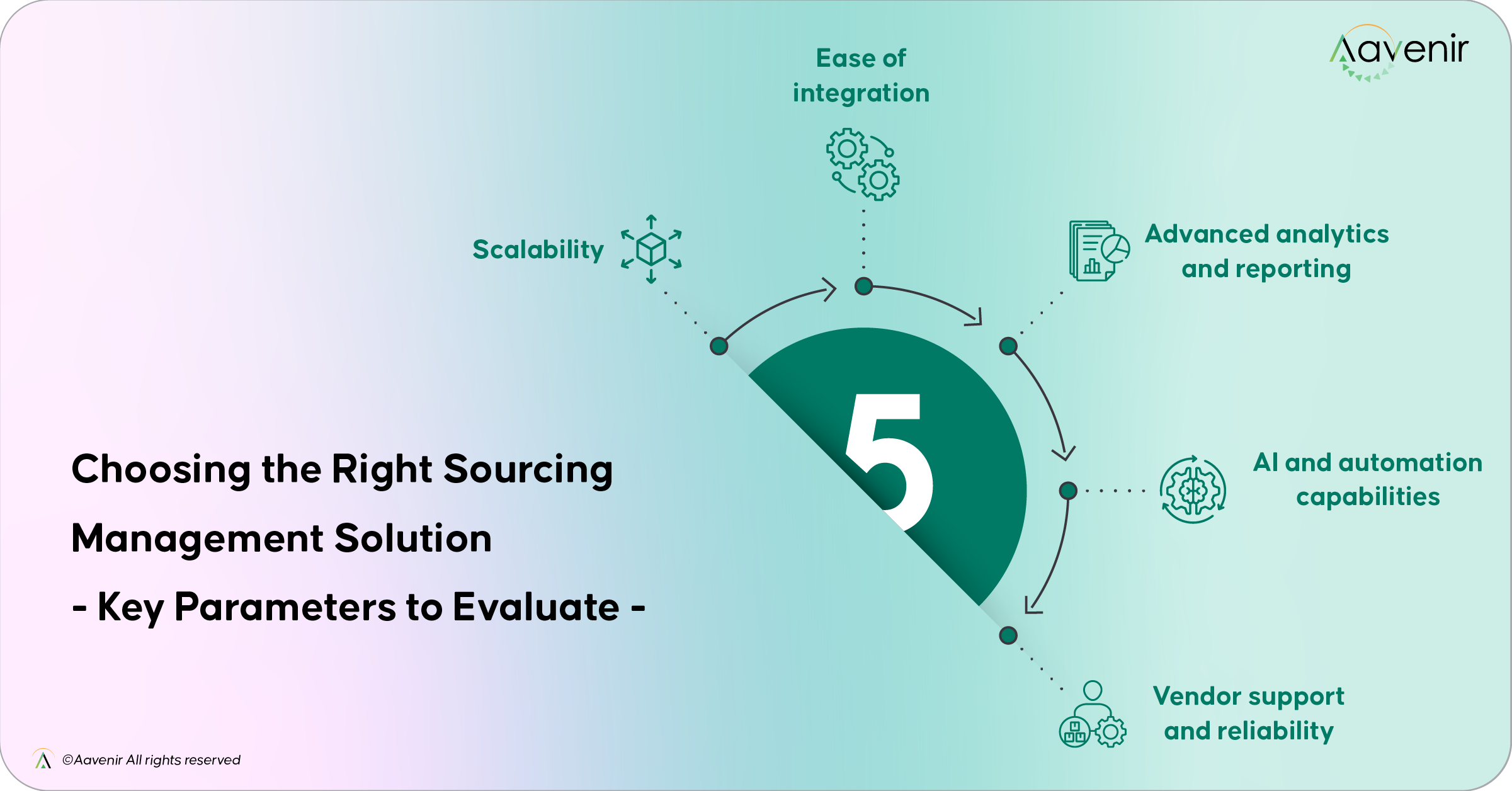
Checklist to Choose the Right S2P Solution for Your Organization
Many S2C and S2P solutions are in the market, catering to different audiences. To simplify your search, you can evaluate these solutions on these five parameters:
- Scalability: The tool should have the potential to handle your future needs without much hassle. Cloud-based solutions like Aavenir can easily handle increased data volumes and users while maintaining performance and uptime.
- Ease of integration: Connecting procurement software with other tools in your tech stack is key for smooth data transfer and process continuity. Aavenir integrates with GRC, ERP, and finance tools to ensure efficient sourcing and procurement.
- Advanced analytics and reporting: Software that generates custom reports and dashboards democratizes data across the organization, unlocking data-driven decision-making at all levels. Organizations have been benefitting from Aavenir’s automated AI analytics, which give insights in seconds.
- AI automation capabilities: The solution should complete action items based on triggers set by the team. This could include sending notifications and following up with stakeholders. Aavenir’s AI functionalities take over such administrative tasks to empower companies to focus on building relationships and making deals.
- Vendor support and reliability: It is crucial to examine whether the procurement software under consideration has a positive reputation in the marketplace. The tool should be robust and secure. Ensure the vendor promptly resolves customer queries and continuously updates the tool.
The objective is to select a reliable, future-proof, easy-to-use, cost-effective solution. Aavenir’s RFPflow checks all the boxes to help enterprises optimize procurement processes through seamless integration, advanced analytics, AI-powered automation, and exceptional support.
Wrapping Up
eSourcing and eProcurement, while interrelated, focus on two different areas. While eSourcing is a strategic process where the suppliers are evaluated, and negotiations are made, eProcurement is a transactional process that handles vendor onboarding, vendor compliance management, vendor relationship management, and payment handling.
Both sourcing and procurement teams leverage RFx documents to complete relevant action items, which can get confusing, especially within cross-functional departments. Organizations must map the corresponding processes clearly while integrating eSourcing and eProcurement.
Moreover, teams must integrate both workflows to achieve efficiency, agility, and compliance. A linear eSourcing and eProcurement workflow will make tracking easier, enabling visibility and increasing stakeholder trust.
Aavenir simplifies this integration with its advanced RFPflow solution, which bridges eSourcing and eProcurement. By automating the RFx lifecycle and providing a unified platform, Aavenir eliminates redundancies and enhances team transparency.
Ready to learn how Aavenir can transform your procurement processes? Contact us today for a free personalized demo.
Frequently Asked Questions
1. What is the main difference between eSourcing and eProcurement?
eSourcing focuses on strategic supplier selection and negotiation before purchasing. At the same time, eProcurement handles the operational procurement processes, such as order placement, invoice processing, and payments, during the purchasing and fulfillment stages.
2. How does eSourcing improve supplier selection processes?
eSourcing leverages tools like RFx management solutions such as Aavenir RFPflow to evaluate suppliers, compare bids, and negotiate terms. This structured, data-driven approach ensures businesses choose the best suppliers based on quality, cost, and compliance criteria.
3. Why is eProcurement important for managing procurement transactions?
eProcurement automates vendor contract management, purchase orders, and payments, ensuring seamless, efficient, and error-free transactions. It enhances compliance, reduces manual effort, and provides visibility into spending, improving overall procurement performance.
4. Can eSourcing and eProcurement systems be integrated?
Yes, integrating eSourcing and eProcurement creates a unified procurement workflow. This integration streamlines supplier selection, order execution, contract lifecycle management, post-signature contract obligation compliance management, and transaction management, enhancing data sharing, collaboration, and efficiency across procurement activities.
5. Why should teams use digital tools for eSourcing and eProcurement management?
Digital tools automate processes, reduce errors, and enhance transparency. They enable real-time tracking, data-driven decision-making, and better supplier relationships, ultimately saving time, reducing costs, and improving operational efficiency.
